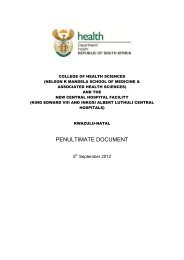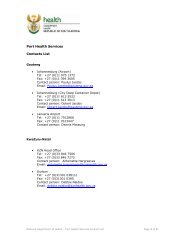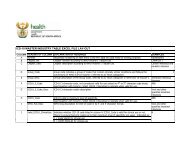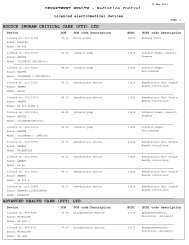National Norms and Standards relating to Environmental Health
National Norms and Standards relating to Environmental Health
National Norms and Standards relating to Environmental Health
Create successful ePaper yourself
Turn your PDF publications into a flip-book with our unique Google optimized e-Paper software.
c) <strong>Health</strong> care facilities should have access <strong>to</strong> a constant, safe <strong>and</strong> adequate water supply. If on-sites<strong>to</strong>rage facilities are available, s<strong>to</strong>rage capacity should be enough for 24hrs.d) Water supply <strong>to</strong> health care facilities should be adequate <strong>to</strong> accommodate other uses, e.g. domesticuses, personal hygiene <strong>and</strong> fire fighting in case of emergencies.e) Water s<strong>to</strong>rage facilities e.g. reservoirs <strong>and</strong> tanks must be adequately protected from contamination.f) EHPs should moni<strong>to</strong>r continuously the water in reservoirs <strong>and</strong> tanks for compliance <strong>and</strong> possiblepollution activities. The water in the s<strong>to</strong>rage facilities must be tested for compliance <strong>and</strong> fitness fromconsumption.g) Water source e.g. borehole, must be effectively protected against contamination.h) If non-compliance is identified when testing of the water, the EHP should then trace the problem back<strong>to</strong> the possible source of contamination. The possible source of contamination must then bemoni<strong>to</strong>red as part of a risk management approach <strong>to</strong> ensure effectiveness of interventions.i) To prevent organisms that grow in temperatures between 25 0 C <strong>and</strong> 50 0 C e.g Ligionella spp hot watertemperatures especially in health facilities, must be kept above 50 0 C <strong>and</strong> cold water below 20 0 C.j) The water supply system that includes the sources (if applicable), pumps, purification plant, taps,pipes, s<strong>to</strong>rage facilities <strong>and</strong> the distribution network linked <strong>to</strong> health facilities should be maintained ingood working order.k) Taps <strong>and</strong> pipes containing water not fit for human consumption must be marked as such.l) The necessary chemicals should continuously be available for water purification, where purification isundertaken by the hospital.m) Designated hospital staff should perform regular moni<strong>to</strong>ring of the water system in the hospital. EHPsmust perform similar moni<strong>to</strong>ring investigations <strong>and</strong> carry out regular quality <strong>and</strong> compliancemoni<strong>to</strong>ring.n) Records of hospital water quality moni<strong>to</strong>ring should be kept.3.2 Toilet <strong>and</strong> ablution facilitiesa) Adequate <strong>to</strong>ilet <strong>and</strong> wash up facilities must be provided in for patients <strong>and</strong> staff on the premises. Atleast 1(one) <strong>to</strong>ilet must be provided for every 15(twelve) patients, <strong>and</strong> 1 (one) h<strong>and</strong> wash basin, <strong>and</strong> 1(one) bath or shower must be provided for every 15 (twelve patients).b) Adequate <strong>to</strong>ilet <strong>and</strong> wash up facilities must be provided for staff on the premises.c) The premises of a health facility must be kept clean <strong>and</strong> all facilities maintained in good order at alltimes.d) Floors of <strong>to</strong>ilet facilities must be constructed of a smooth <strong>and</strong> easily cleanable material.e) Walls must be of a smooth finish <strong>and</strong> painted with a light coloured, washable paint or tiled.3.3 Waste managementApproved methods of waste collection, s<strong>to</strong>rage, transportation <strong>and</strong> disposal must be adopted.A facility waste management plan <strong>and</strong> a waste management policy must be developed <strong>and</strong>implemented.Approved methods of waste collection, s<strong>to</strong>rage, transportation <strong>and</strong> disposal must be adopted <strong>and</strong>must be in line with SANS 10248.A waste management officer must be designated for each facility, responsible for only themanagement of waste (general <strong>and</strong> health care risk waste)a) The collection, s<strong>to</strong>rage <strong>and</strong> disposal of general waste, must be managed in accordance with therequirements as specified in Part U of the <strong>National</strong> Building Regulations <strong>and</strong> Section 2-5 of the <strong>Norms</strong><strong>and</strong> St<strong>and</strong>ards for Waste Management;b) An approved refuse area must be provided on the premises for the s<strong>to</strong>rage of all refuse pendingremoval;c) Access <strong>to</strong> waste s<strong>to</strong>rage facility must be limited <strong>to</strong> employees who have been trained with respect <strong>to</strong>the operation of a waste facility;d) An adequate number of refuse bins must be provided for the s<strong>to</strong>rage of general waste on thepremises; <strong>and</strong>e) Measures must be taken <strong>to</strong> prevent access of the public or unauthorized personnel <strong>to</strong> health care riskcontainers.DOH. <strong>Norms</strong> <strong>and</strong> st<strong>and</strong>ards for environmental health in South Africa Feb 2013 49


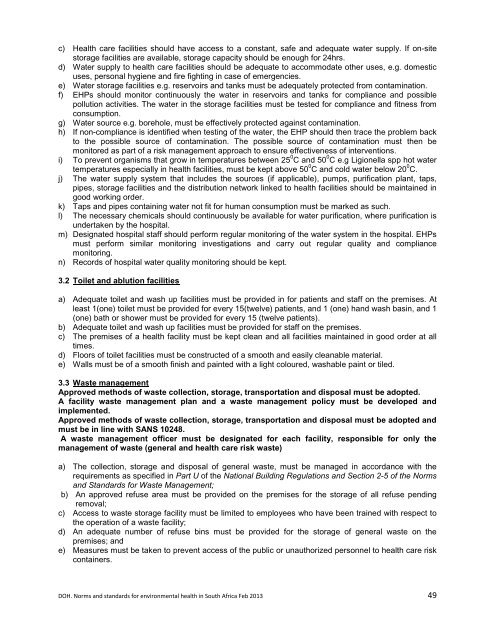


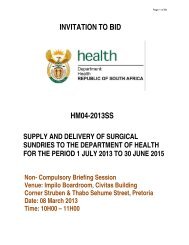
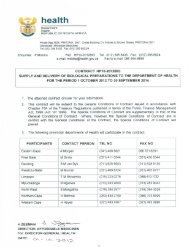
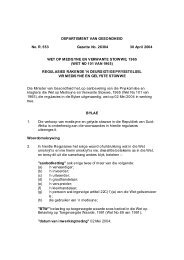
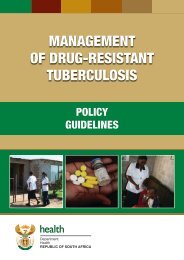
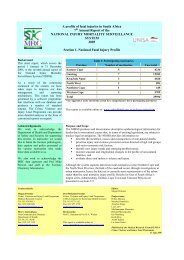
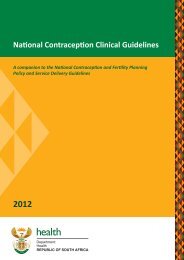
![A monograph of the management of postpartum haemorrhage [2011]](https://img.yumpu.com/15578784/1/184x260/a-monograph-of-the-management-of-postpartum-haemorrhage-2011.jpg?quality=85)
